1,000 days of COVID-19: Looking back on the pandemic's impact since N.L.'s 1st case

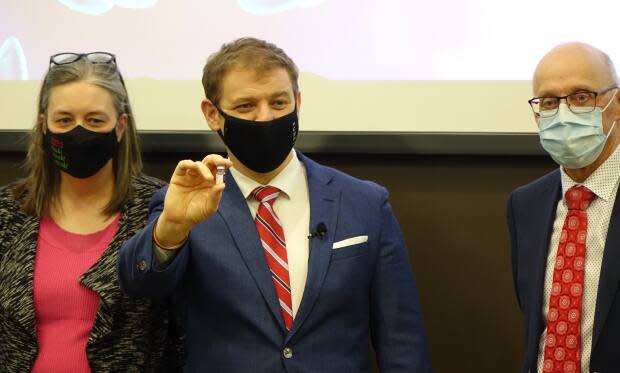
Newfoundland and Labrador marked its first case of COVID-19 on March 14, 2020 — Day 1 of the pandemic in the province. More than three and a half years later, Thursday marks Day 1,000.
Between the two dates, the provincial government has reported more than 53,500 positive cases, but that number doesn't represent the true number of infections, as it includes only PCR tests done by regional health authorities, not rapid tests done at home by the public. The provincial government also began strictly limiting who was eligible for a PCR test months ago.
Remember the long lineups outside of major retail chains? The curbside pickup options for small businesses adapting to the changing landscape in order to stay afloat? The new hobbies as people tried everything they could to break up the day-to-day monotony, between Zoom meetings, while stuck at home? The vaccine passport? Cheeky quotes from elected officials?
There have been 279 deaths so far. There was a provincial election that was interrupted by an outbreak and court challenges. There were cancellations of concerts, festivals and sporting events. Families were separated by restrictions at long-term care and personal-care homes.
Travel restrictions decimated the tourism and hospitality industries. The "Atlantic bubble" was a relatively short-lived phenomenon. A semi-cancelled Christmas, vaccines, booster shots, mask mandates and testing — the list goes on.
But Chief Medical Officer of Health Dr. Janice Fitzgerald said things seem to be taking a turn.
"Right now it certainly appears that we are transitioning to COVID becoming an endemic disease, and I hope a seasonal disease although we're still waiting to see what will happen there," Fitzgerald told CBC News on Wednesday.
"I think we're going to have situations where we are going to see surges in COVID and it may take a little while for it to settle into a seasonal pattern."
Here's a look back over the first 1,000 days of the COVID-19 pandemic — which is still not over.
The firsts
The public was broadly introduced to Fitzgerald in early March 2020. She would become the face of public health while at the helm of the province's decisions and reactions to COVID-19, which had yet to surface in Newfoundland and Labrador by that point.
Her first news conferences were just an insight into things to come. At first they were sporadic, providing important information from outside the province as COVID-19 cases spread across Canada with little known at the time about the virus. Before long, the news conferences became daily events, and much of the province would watch or listen to hear the latest news.
On March 13, Fitzgerald called the spread to N.L. "inevitable." A day later, she announced N.L.'s first presumptive case of COVID-19.
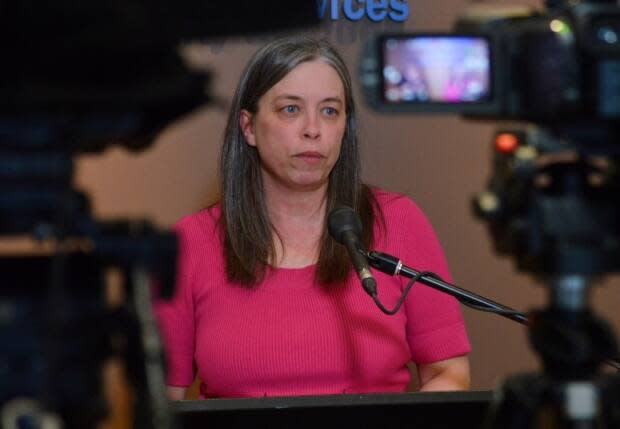
On March 16, N.L. introduced its first sweeping closures, starting with schools and daycares, and Fitzgerald, Premier Dwight Ball and Health Minister John Haggie urged cancelling plans with large crowds and avoiding packed grocery stores.
Haggie declared a public health emergency in the province just two days later. Gyms, theatres, bars and arenas were among the first businesses to be ordered closed. More followed, while restaurants had their operating capacity cut in half.
More cases cropped up over the next couple of weeks — more than 100 of them — in what became known as the "Caul's cluster," after a funeral in St. John's. It was among the first clusters in Canada and the province's first glimpse at how quickly COVID-19 can spread.
On March 30, just two weeks after the province's first case, Fitzgerald announced N.L.'s first death from the virus: a 78-year-old man connected to the Caul's cluster.
"This is a solemn day for our province," Ball said at the time.
As a whole, Canada was reporting just 67 deaths countrywide at the time. That number is just over 48,000 today.
The unprecedented election
The province fell into what became a "new normal" over the following months, attempting to reach goals within the newly introduced alert level system, which outlined what people could and could not do based on the prevalence of COVID-19 in the community.
Staying home, keeping contacts low, wearing masks and keeping distance became a new way of living. Parks and playgrounds closed over the summer but trails were open for walking. Curbside pickup became the new way of doing business.
The month before N.L. had its first COVID-19 cases, Ball had announced his intention to step down as premier. The pandemic delayed those plans, and he ultimately stayed on until August, when a Liberal leadership race elected Andrew Furey to run the ship.
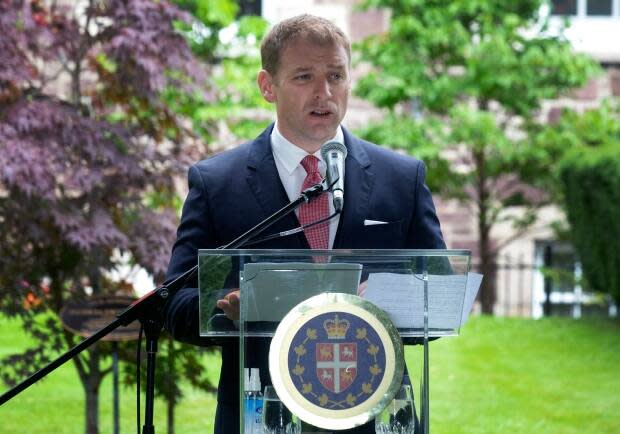
Furey was sworn in shortly after but still needed a seat within the House of Assembly as an elected official to sit as premier.
In January 2021, with COVID-19 cases seemingly cooling — the province had only five active at the time — he called the general election for February and was immediately met with criticism from the opposition.
N.L. winters are wildly unpredictable and the deadline for the highly anticipated Greene report from the premier's economic recovery team was still months away. Furey also had one year, by law, to call an election from the day he was sworn in.
"It's a little suspicious that the premier thinks it's a good idea to call the election now, instead of waiting for these recommendations and [letting] the public judge the Liberal government based on those recommendations," provincial NDP Leader Allison Coffin said at the time.
COVID-19 cases remained relatively low through the end of January and into early February but the situation quickly changed.
On Feb. 8, 2021, the province reported 11 new cases, the first double-digit day since the Caul's cluster nearly a year before. Feb. 9 saw 30 cases. Feb. 10 had 53 more. Most were connected to two schools in Mount Pearl and the arrival of the B117 variant, which prompted public health to quickly set up more testing sites throughout the northeast Avalon Peninsula.
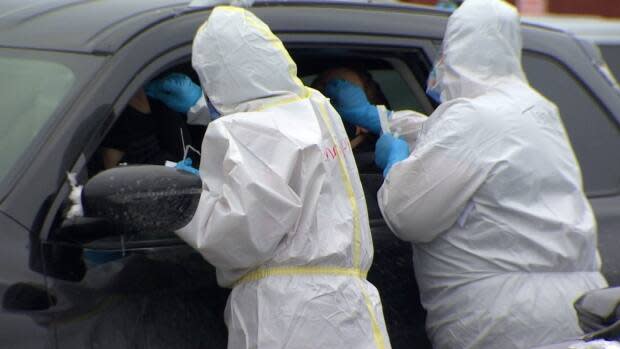
On Feb. 11, just two days before voters were set to go to the polls, Fitzgerald announced the province had 100 new cases, the largest single-day total to that point.
The following evening, Fitzgerald moved the entire province into Alert Level 5 — the most restrictive — while the province's chief electoral officer, Bruce Chaulk, cancelled all in-person voting for election day in favour of mail-in voting.
Early and special mail-in ballots had already been cast, and remaining voters scrambled to submit requests for mail-in voting kits.
On March 27, 2021, all votes were finally counted. Furey had won with the Liberals claiming a slim majority, while Coffin and PC Leader Ches Crosbie lost in their own districts.
Vaccines and health care
But leading up to what would turned out to be an election unlike any other in Newfoundland and Labrador history was the arrival of COVID-19 vaccinations.
On the global stage, companies were hurriedly working on their products in the background.
Pfizer-BioNTech, Moderna and AstraZeneca were the first out of the gate, with the provinces and territories sharing a national supply based on population.
First doses landed in N.L. on Dec. 15, 2020, just 10 days before Christmas and a month before Furey called the election.
"In that plane represents hope for 2021," said Furey on the tarmac at St. John's International Airport.
The rollout strategy was straightforward: first doses would go to the elderly, the most vulnerable and front-line first responders and health staff. As more doses trickled in, and previous groups were largely vaccinated, shots started going into the arms of descending age brackets.
Fitzgerald administered the first dose personally, just a day after the vials arrived.
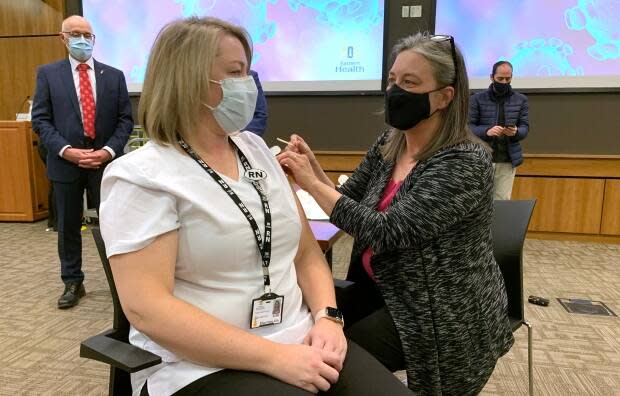
Months ticked by while children under 12 years old remained mostly unprotected from the virus. Clearances were needed from the national health body before vaccines could be administered to children between five and 12 years old.
By late November 2021 approval had been given, and kids began receiving first doses on Nov. 25. Fitzgerald, once again, administered the first batch.
Children under five years old would have to wait until the summer of 2022 to get their shots, with first doses administered on Aug. 1 of this year.
To date, 92.9 per cent of the province's population over five years old is fully vaccinated.
The vaccines were touted as a way to keep severe illness numbers down while the health-care system strained under the pressure of the pandemic — resulting in staffing shortages, overfilled ERs and lengthening wait times, all of which still plague the province today.
Schools and the turnaround
The province's public school system was also hit hard by the pandemic, with staff attempting to deliver education to students under a constantly changing situation.
Students were sent home on March 16, 2020, two days after the first case was announced. In-person classes, public exams, school activities, outings and travel were cancelled for the rest of the school year.
Students finished the year in virtual classrooms, as the Newfoundland and Labrador English School District scrambled to ensure online resources were available for students with a focus on the graduating class.
The province's caseload began to dwindle over the summer of 2020, allowing Fitzgerald to lower the alert level and for businesses and leisure activities to resume, with some restrictions still in place. The plan from the provincial government and the school district was to have kids back in class to begin the new school year in September.
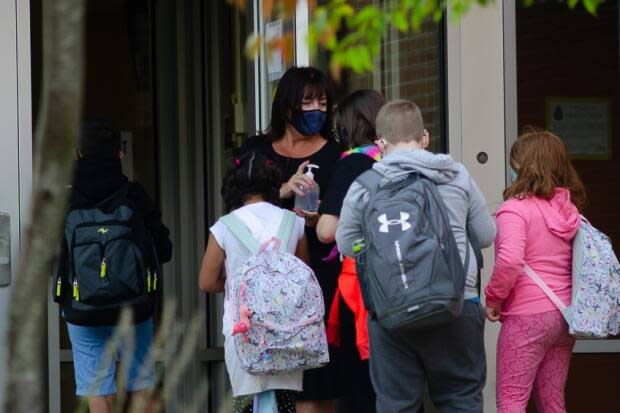
About 64,000 students from K-12 returned that fall, with heavy restrictions in place, including cohorts, a ban on school sports and mandatory masking.
But COVID-19 cases began to skyrocket in December 2021 with the arrival of the Omicron variant. Between Dec. 13 and Dec. 31, the province reported 2,077 cases — an average of more than 100 per day — and Fitzgerald moved the entire province to Alert Level 3 on Dec. 22, bringing back heavier restrictions — including visitor restrictions at seniors' homes — just days before Christmas.
"Today we need to face things as they are, not as we want them to be," Fitzgerald said while wiping away tears after delivering the unwelcome news to the public just days before families were set to gather to celebrate the holidays.
Following the Christmas break, students didn't return to in-person classes until late January, with the return hinging on two negative COVID-19 tests taken at home.
The provincial mask mandate was dropped in March, although Fitzgerald recommends continuing to wear them in public spaces, and fall 2022 looked much different again as the province returned to life largely without COVID-19 restrictions.
"It is time to get back to our new normal, and this is another step along that road," said Haggie at the time.
Businesses struggle, some bounce back
Pandemic travel restrictions dealt a heavy blow to the tourism and hospitality industry, while capacity restrictions and complete closures in the early months of 2020 also hurt other small businesses.
Tourists couldn't make the journey while foot traffic from locals was at an all-time low.
Government officials touted a "Stay Home Year" for the summer of 2020, urging people to support local businesses and explore their home province with a "staycation."
It was a small boost that business owners needed but many still struggled. Some didn't reopen their doors at all.
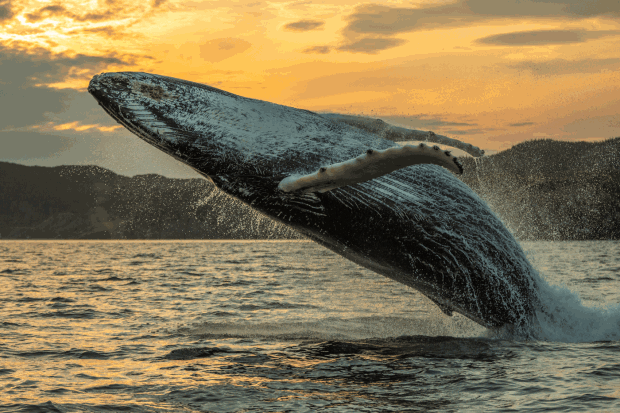
The launch of the provincial government's Come Home Year campaign in 2022 provided a stark contrast to the previous two years. The end of restrictions meant visitors could return without too many challenges, including on cruise ships and in a steady flow through St. John's International Airport.
Municipalities got funding for home-brewed projects and events, while tourism operators basked in the return of regular traffic from outside N.L., something most rely heavily on.
The province also saw the return of massive gatherings with festivals on George Street, the Royal St. John's Regatta and the Iceberg Alley concert series.
And even after 1,000 days, the pandemic is far from over. Newfoundland and Labrador continues to report hundreds of new cases and a handful of deaths each week, even as the province moves past the uncertainty that marked the early days of COVID-19 toward — when the World Health Organization makes an official declaration — what will be a post-pandemic life.


